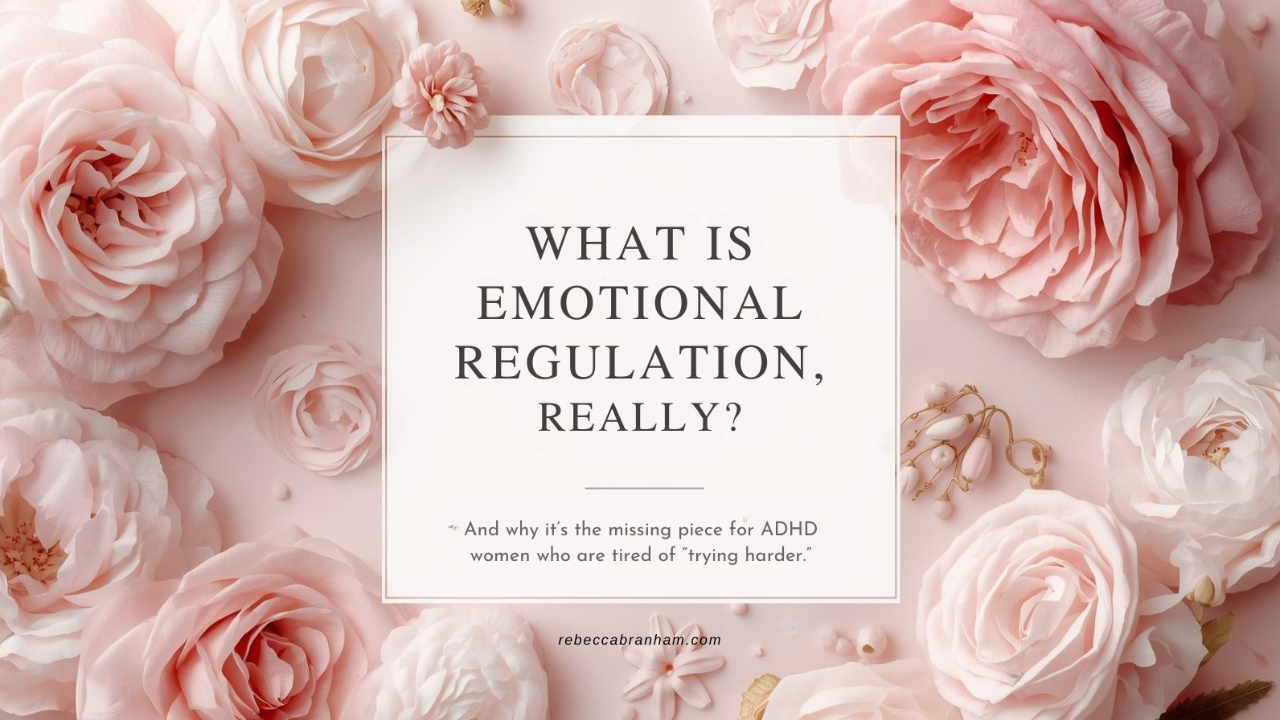
What Is Emotional Regulation (Really)?
Nov 03, 2025And why it’s the missing piece for ADHD women who are tired of “trying harder.”
You’ve heard it before:
“You just need to regulate.”
Cool. But what does that actually mean…
…when your brain feels like a browser with 47 tabs open
…and your body’s constantly stuck between overdrive and shutdown?
Let’s break it down, no psych degree required.
What Emotional Regulation Actually Is
Emotional regulation is your ability to notice what’s happening inside your body and respond in a way that supports you instead of sabotaging you.
It’s not about being chill or calm all the time.
It’s about being able to come back to center when life throws chaos at you.
Or when your inbox explodes.
Or when your toddler melts down and your brain does too.
Think of it like an internal dimmer switch:
When you’re dysregulated, the light is either blindingly bright (panic, urgency, rage)…
or totally off (numb, shut-down, checked out).
Regulation helps you adjust the brightness so you can actually see what’s going on and choose your next move from a grounded place.
👉 According to the National Institute of Mental Health, ADHD affects executive function, including the parts of your brain responsible for emotional regulation and impulse control.
Why ADHD Brains Struggle with Regulation
ADHD doesn’t just make you “distractible.”
It makes you feel everything louder and longer.
Your nervous system fires faster.
Your dopamine dips harder.
And your prefrontal cortex, the logic part, goes offline just when you need it most.
So instead of staying steady, you might:
-
Snap and feel guilty five minutes later
-
Avoid tasks you care deeply about
-
Spiral after one small interruption
-
Crash after a hyper-focused sprint
-
Feel “lazy” when you’re actually maxed out
You’re not flaky.
You’re not broken.
Your system just never learned what safety feels like — yet.
👉 A 2014 study in Frontiers in Human Neuroscience found that adults with ADHD experience higher emotional reactivity and slower recovery time after stress.
What Dysregulation Looks Like in Real Life
👩💻 If You’re an Entrepreneur
-
You freeze before hitting publish because “what if it flops?”
-
You jump from idea to idea, chasing clarity but finding burnout.
-
One piece of feedback spirals into “I should quit.”
-
You can’t tell if you’re unmotivated or just done.
Regulation in business looks like:
→ Pausing before pivoting.
→ Being able to stay with a project.
→ Showing up even when it’s not perfect.
🧠 If You’re Not a Business Owner
-
You scroll instead of doing the thing because your system’s already maxed.
-
You say “yes” to something you don’t want to do, then stew about it all day.
-
You overreact to small stuff and can’t figure out why.
Regulation in everyday life means:
→ Feeling your emotions without being run by them.
→ Responding instead of reacting.
→ Letting your nervous system lead, not hijack, your day.
Why This One Skill Changes Everything
When you can regulate, you can:
-
Focus longer (without white-knuckling it)
-
Communicate without blowing up or shutting down
-
Follow through on things that matter to you
-
Recover faster when life hits hard
-
Stay consistent without burning out
According to Harvard Health Publishing, emotional regulation is directly linked to better mental health, stronger relationships, and higher resilience.
It’s not just a “nice-to-have.”
It’s the foundation for everything else.
How to Start Building Regulation
You don’t need to overhaul your life.
Here’s where to begin:
-
Notice the signal.
That moment your chest tightens or your brain fogs over? That’s data. -
Name what’s happening.
“I’m anxious.” “I’m overstimulated.” “I’m emotionally checked out.”
Naming it interrupts the spiral and helps your brain feel safer. (Psychology Today explains why) -
Do one regulating action.
Ground your feet. Breathe slow. Shake it out. Take a lap. Use my Emotional Ladder Scale Reset.
That’s it. That’s the start.
🧠 What Does Your ADHD Brain Need Most?
Every nervous system has a different regulation language.
Some need structure.
Some need rest.
Some need movement, space, or sensory input.
✨ Take my free Get Started Quiz to find out what your system needs and get a personalized next step to support it.
If You’re Ready to Go Deeper
I’ve got a few places you can explore next (these blogs will be published soon):
-
How to Regulate Before You React
-
Regulated Routines for ADHD Entrepreneurs
Or if you’re ready to stop just reading about it and actually start practicing…
Join me inside Regulated & Rising - my monthly space for women building steady rhythms in real life.
Because regulation isn’t just about calming down.
It’s about creating a life that actually feels safe to be in.
References

